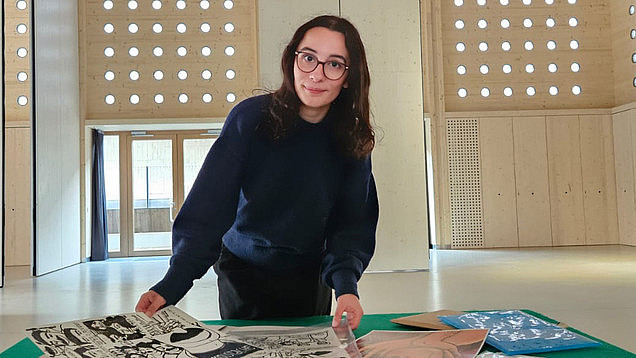This page contains automatically translated content.
Curating is more than making exhibitions

The word "curating" comes from the Latin verb curare, which means "to care for" or "to look after". In the narrower sense, however, curating means exhibiting artistic works and artworks in public. Kızılöz explains the classic core tasks of curators: "This includes preserving a collection, researching individual works, continuing to build a collection and exhibiting". On the last point, she criticizes: "I observe that the understanding of curating today has shifted more and more towards curators only making exhibitions. But the curator's range of tasks encompasses much more." In the meantime, "curating" has become established in other professional fields such as film and theater festivals. Program makers are referred to as curators. Kızılöz comments: "I don't want the word curating to be used in an inflationary way for putting together an event."
Curators mainly work in art galleries, galleries and museums. Depending on the institution, they are responsible for the conception, organization and realization of exhibitions in coordination with the management. In a museum, for example, they manage a project for the respective exhibition across departments, manage the exhibition budget, take care of loan acquisition and project-related fundraising. In addition, curators are responsible for the conception and production of exhibition publications to accompany special exhibitions and for developing concepts for a program of events in collaboration with the education and outreach department. The range of tasks listed depends on the personnel and financial resources of an institution. In smaller institutions in particular, several functions are often combined in one position.
The curatorial volunteer at the School of Art and Design Kassel is an interface between the rectorate, the press office and the exhibitors in the exhibition hall. Kızılöz summarizes her tasks as follows: "I work on the concept for program development and coordinate the smooth running of various formats such as exhibitions, readings, screenings and workshops in the exhibition hall." For Kızılöz, the traineeship offers her the advantage of working with artists, designers and researchers. She also works closely with the "Exhibition Hall Working Group", where content issues are discussed and the annual program in the exhibition hall is determined. "The working group is very important for my training. I can clarify content-related questions about curatorial practice with those involved in the working group," says the trainee. She is also in professional contact with her training mentor Prof. Dr. Martin Schmidl (Rector of the Kunsthochschule) and works with him on specific projects.
Defne Kızılöz is currently curating the exhibition "There's the river, you've got the bucket!" together with Lea Heinrich and the students from the art studies course. 20 years of comics and illustration in Kassel" (opening on 20.10.23, 6 pm). As part of the exhibition, the team will also be looking at historical issues relating to the emergence of comics.
Those interested in a curatorial traineeship should have the soft skills of social communication and patience. "Our work requires a lot of communication and patience," emphasizes Kızılöz. And she adds with a laugh: "If something doesn't work out immediately in the project process, you shouldn't let yourself get demotivated and think in a solution-oriented way. No matter how hopeless the situation sometimes looks, everything will work out in the end."
Before starting her training at the art academy, Kızılöz studied archaeology, art history and economics at Martin Luther University Halle-Wittenberg (MLU). After completing her bachelor's degree, she completed her master's degree in art history at the University of Leipzig. She specialized in modern and contemporary art from 1850 onwards and European architectural history. Defne Kızılöz already has plans for what to do after her traineeship. She wants to do a doctorate in the field of modern art history.
(Text: Çiğdem Özdemir)